Bulletin – March 2018 Payments High-denomination Banknotes in Circulation: A Cross-country Analysis
- Download 752KB

Abstract
In Australia, Canada and the United Kingdom, the number of high-denomination banknotes in circulation has increased at an above-trend rate in recent years. Evidence suggests that overseas demand might be a common driver of this elevated growth. Increased domestic demand for both transaction and store-of-value purposes may also have contributed, as well as responses to changes in government and central bank policies. This research was undertaken with assistance from members of the Four Nations Distribution Working Group, in line with the group's objective to explore banknote-related topics that are directly relevant to the member central banks.[1]
Introduction
Banknotes continue to have an important role in the payments systems of most developed countries. Over the past decade, annual growth in the value of banknotes in circulation in Australia, Canada and the United Kingdom has been around 6–7 per cent. Demand for banknotes should increase broadly in line with population growth, inflation and real activity, assuming no change in behaviour. In reality, banknote demand has outstripped nominal economic growth in Australia, Canada and the United Kingdom for some time (Graph 1). The ratio of the value of banknotes in circulation to nominal GDP in Australia is currently close to its 50-year peak at around 4 per cent (Lowe 2017). The ratio in Canada and the United Kingdom is also around multi-decade highs at close to 4 per cent. The experience of Australia, Canada and the United Kingdom is not unusual; the ratio of banknotes in circulation to GDP is noticeably higher and growing at a faster rate in the G3 economies, whose currencies are considered major global reserve currencies, and in Mexico, another member of the Four Nations Distribution Working Group.[2]
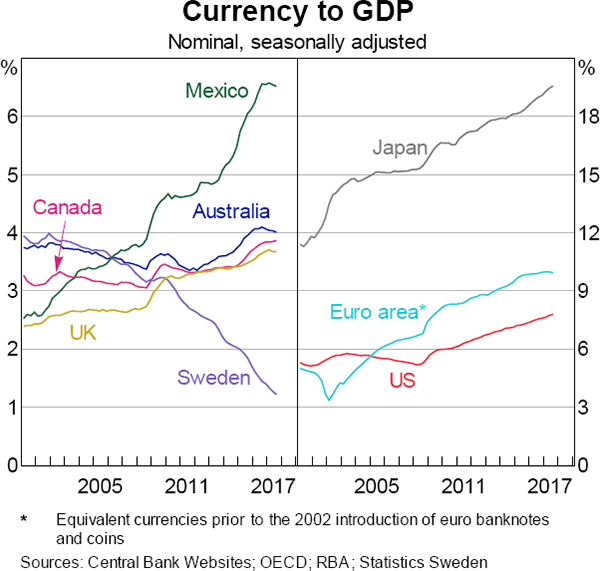
The value of each denomination in circulation has grown broadly in line with long-term trends in Australia, Canada and the United Kingdom. However, growth has been strongest for the highest denomination, namely the AUD 100, CAD 100 and GBP 50 banknotes. In the mid 2000s, growth in nominal GDP appeared to explain almost all of the growth in high-denomination banknotes in circulation. The onset of the global financial crisis coincided with a significant level shift in demand for CAD 100 and GBP 50 banknotes, as well as a temporary increase in demand for AUD 100 banknotes (Graph 2). This higher level of demand for CAD 100 and GBP 50 banknotes remained broadly steady until 2012, when demand for high-denomination banknotes in all three countries started to trend higher. Growth in circulation has slowed more recently for AUD 100 and GBP 50 banknotes.
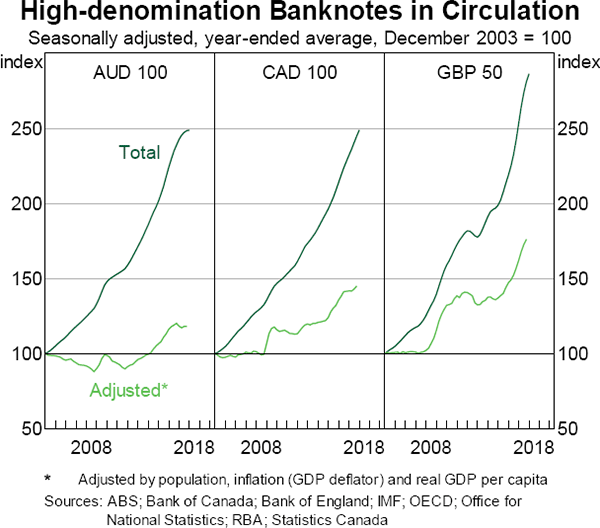
This article explores the contributions of domestic factors, overseas factors and government and central bank policies to the recent strong growth in AUD 100, CAD 100 and GBP 50 banknotes in circulation. We evaluate supporting evidence for each factor and, where possible, examine its relative importance to demand for high-denomination banknotes using a regression framework (see Appendix for a discussion of the regression method). It is also possible that some proportion of demand for high-denomination banknotes arises from individuals and businesses operating in the shadow economy, which is outside the tax and regulatory system. However, by definition it is not possible to accurately assess demand for banknotes as a result of these activities. Given that our analysis is largely empirical, we do not seek to assess the shadow economy's contribution to demand for high-denomination banknotes.
Domestic Demand
Transactional use
Transactional use of high-denomination banknotes in Australia, Canada and the United Kingdom is low relative to other denominations but is important to some sectors of the economy. For example, the Reserve Bank of Australia's (RBA's) cash sampling program suggests that AUD 100 banknotes are used at a range of retailers; AUD 100 banknotes account for up to 5 per cent of cash banked by retailers and supermarkets and 10 per cent for post offices (where consumers often pay household bills) (Davies et al 2016). A 2013 Bank of England survey found that around one-quarter of respondents had used a GBP 50 banknote in the past year, while a Bank of Canada survey from the same year found that residents aged over 55 years or from rural areas were the segments of the population most likely to hold high-denomination banknotes (Fish and Whymark 2015; Henry, Huynh and Shen 2015).
While the anonymity of cash use makes it impossible to directly observe the transactional use of particular denominations, we use other metrics to learn about trends in this type of use.
In Australia, banknote lodgement data measure the flow of banknotes from retailers and banks into commercial cash depots and provide evidence that the transactional use of AUD 100 banknotes has trended higher since 2013 (Graph 3).[3] Adding support to these observations, liaison with Australian commercial banks indicates that they are increasing the number of ATMs that dispense AUD 100 banknotes. The banks attribute this to more cost-effective ATM management practices but also to growing public demand, particularly in areas with large migrant populations.
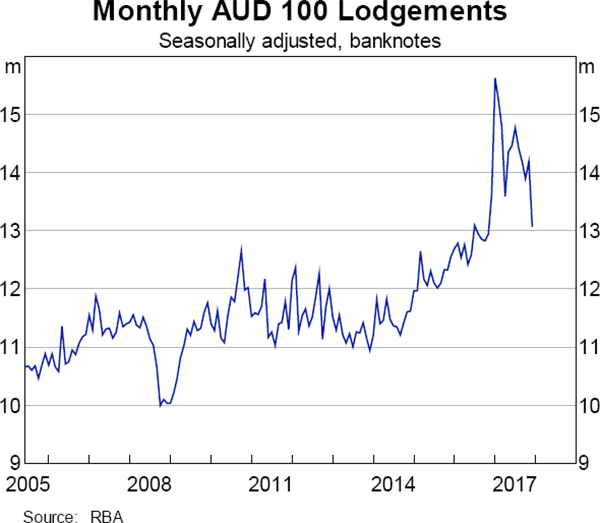
Another proxy for transactional use is the ratio of unfit banknotes returned to central banks relative to the volume of banknotes in circulation. This ratio would be expected to increase if transactional use increased (the more a banknote is used, the more quickly it becomes unfit), although with a lag. In the case of AUD 100 banknotes, the ratio appears to have increased in 2017 after very little change in the previous four years.
The data for CAD 100 and GBP 50 banknotes are less conclusive, but potentially suggest a stabilisation or slight increase in the transactional use of these banknotes. These international data are complicated by the introduction of new series CAD 100 and GBP 50 banknotes and the redemption of old series banknotes that are worn beyond effective use.[4] Nevertheless, liaison by the Bank of Canada and Bank of England suggests that the use of high-denomination banknotes in ATMs has been increasing, although from low levels. For example, in the past the use of GBP 50 banknotes in ATMs was relatively limited and concentrated in London. Some commercial banks have initiated pilot programs to make this denomination more widely available. Public reaction to these trials has generally been positive.
This analysis provides some tentative evidence that the use of high-denomination banknotes as a means of payment has recently increased. When tested in a regression framework, the value of retail sales (a proxy for transactional use) tends to be positively correlated with high-denomination banknotes in circulation but of limited statistical significance after controlling for other factors (Table A1). The limited statistical significance might reflect the weakening contribution of retail sales (and transactional demand) to overall demand for high-denomination banknotes.[5]
Demand for high-denomination banknotes as a means of payment may also be linked to changes in household wealth (to the extent that households spend any increase in wealth and use banknotes in transactions). Some of this spending would involve retail transactions, but it could also include other expenditure such as household renovations. Using housing prices as a proxy for household wealth, we find that a 10 per cent increase in Canadian housing prices is associated with about a 1 per cent increase in CAD 100 banknotes in circulation, a correlation that is statistically significant at the 1 per cent level in the full and post-crisis samples Table A1. The correlation is also positive for AUD 100 and GBP 50 banknotes but is of limited statistical significance. In addition, in the full-sample model, we found a statistically significant positive correlation between the value of alterations and additions to residential dwellings and AUD 100 banknotes in circulation. This may indicate greater relative cash use in the construction industry. Judson and Porter (2004) found a similar result for US dollar banknotes and variables related to housing construction.
Store of value
Consumers holding banknotes as a store of value is another source of domestic demand for high-denomination banknotes. Consumer survey data point to a range of reasons why consumers hold cash in places other than their wallets. Common reasons noted across Australia, Canada and the United Kingdom include: emergency transactions, precautionary saving, low interest rates, and perceptions of domestic and global economic and financial conditions (Fish and Whymark 2015; Henry, Huynh and Shen 2015; Doyle et al 2017).[6]
The value of banknotes held outside of wallets varies greatly across consumers. While survey data likely underestimate the full extent of store-of-value demand for a number of reasons, such as reluctance to provide information on the true amounts held outside of wallets and sampling bias, they can provide useful insights on general behaviours. Around 70 per cent of participants in the RBA's 2016 Consumer Payments Survey reported holding cash outside their wallets (Doyle et al 2017). A 2009 survey found that 63 per cent of Canadians hold cash outside their wallets (Arango and Welte 2012). Surveys conducted in the United Kingdom have produced mixed results depending on the method, with estimates of the proportion of the population holding cash outside their wallets ranging from 20–40 per cent (Miller 2017). Most households holding cash outside their wallets hold relatively small values. This suggests that large holdings of banknotes for store-of-value purposes are concentrated in a relatively small number of households.
Another source of anecdotal information is central bank-processed damaged banknote claims. Over the past five years, the RBA has received several claims in excess of AUD 20,000 where ‘house fire’ was cited as the cause of damage (Flannigan and Staib 2017). Among claims over AUD 5,000, around one-quarter (by value) were held in AUD 100 banknotes. Over the last three years, around 5 per cent of damaged banknote claims over CAD 10,000 received by the Bank of Canada have been related to heat-damaged banknotes, though these data include commercial bank claims as well as household claims. Data on mutilated banknote claims received by the Bank of England show that of the claims attributed to GBP 50 banknotes in 2016, 10 per cent by value and 4 per cent by volume were ‘burnt and heat damaged’.[7]
The store-of-value function performed by high-denomination banknotes appears to be particularly important during times of significant financial instability, such as the global financial crisis. Cusbert and Rohling (2013) explain that concerns about the solvency of financial institutions can prompt both depositors to withdraw their funds and commercial banks to increase their precautionary holdings of banknotes. At the same time, a decline in interest rates reduces the opportunity cost of holding cash, while a depreciation of the exchange rate makes converting banknotes into a foreign currency less attractive. Year-ended growth in demand for AUD 100 and CAD 100 banknotes increased sharply during the global financial crisis, and shortly before the crisis for GBP 50 banknotes (Graph 4).
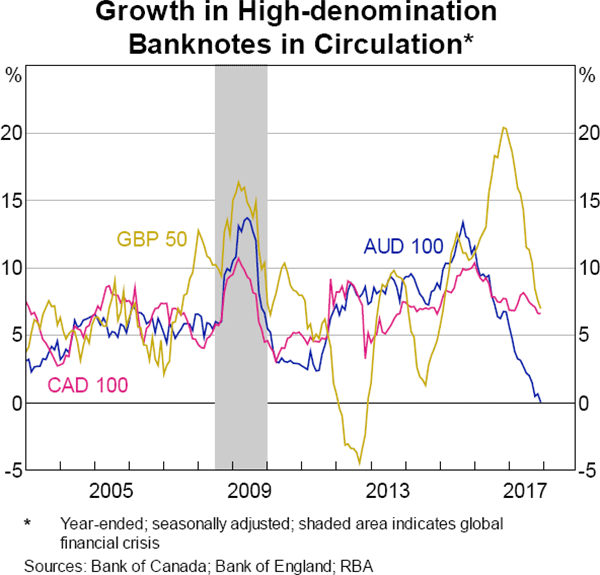
The evidence suggests that store-of-value motives are an important driver of demand for high-denomination banknotes, implying that a larger stock of banknotes is needed to support a given level of transactional demand (Flannigan and Staib 2017). Indeed, at least one dummy variable for the global financial crisis is statistically significant in each of our full-sample regressions, which may indicate that concerns about global and domestic economic and financial market conditions boosted demand for high-denomination banknotes (Table A1). This is supported by the level shift in demand for CAD 100 and GBP 50 banknotes experienced during the financial crisis (Graph 2).
There is anecdotal evidence that, outside of financial crises, the use of cash as a form of precautionary saving is relatively insensitive to short-term uncertainty. Consistent with this, other variables such as interest rates, option-implied share market volatility, and economic and policy uncertainty indices are not statistically significant determinants of demand for high-denomination banknotes in our models.
Overseas Demand
Overseas demand is an increasingly important component of demand for high-denomination banknotes. In Australia, Canada and the United Kingdom, the highest denomination banknote is believed to account for the majority of currency sent abroad. This is evident from the persistent correlation between US dollar exchange rates and growth in high-denomination banknotes in circulation over time (Graph 5).
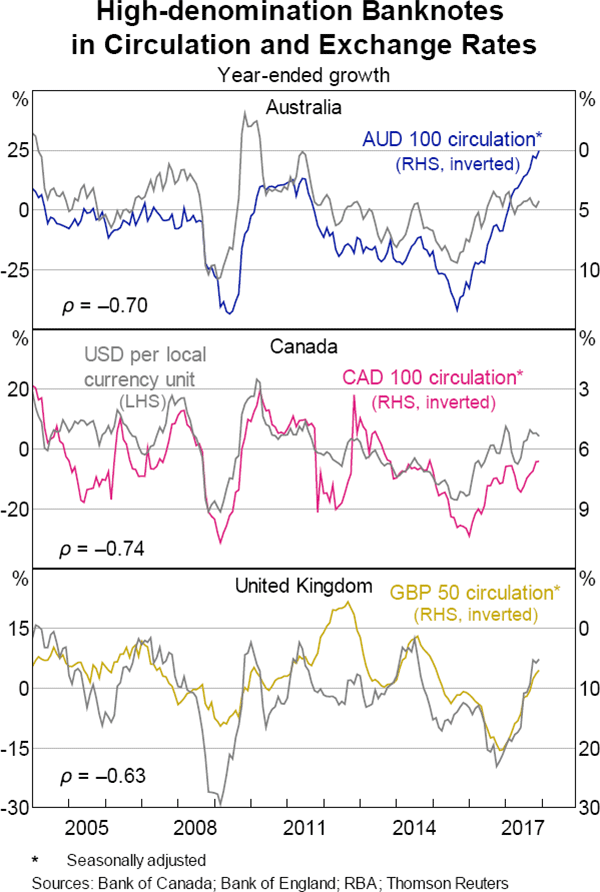
There are several reasons why individuals may choose to hold high-denomination banknotes in a foreign currency. One reason could be travel to these countries, particularly for tourism or educational purposes. Following a depreciation of the exchange rate, travellers already in a country are able to purchase more foreign currency for a set budget. There is also likely to be a lagged effect, to the extent that some purchases of foreign currency occur after the decision is made to travel but in advance of actual travel, when exchange rates are perceived to be favourable. High-denomination banknotes are often preferred in these situations as they are the least costly storage and transportation option (Flannigan and Staib 2017). Liaison with foreign exchange companies and our regression results support an immediate and lagged correlation between exchange rate movements and overseas demand for high-denomination banknotes (Table A1). It is also possible that regular tourists and business travellers hold foreign banknotes, including high denominations, for subsequent travel, thereby contributing to the value of banknotes on issue.
Another motivation behind overseas demand for foreign high-denomination banknotes could be wealth diversification or, more generally, capital flight. While the United Kingdom has been an important destination for overseas capital flows for a long period, overseas demand for high-denomination banknotes might have been supported by the relative stability of these countries' financial systems during the global financial crisis.[8]
Our regression analysis suggests that a 10 per cent depreciation in the US dollar exchange rate is associated with a 1–2 per cent increase in AUD 100, CAD 100 and GBP 50 banknotes in circulation over a 2–3 month horizon (Table A1). The correlations are most economically and statistically significant for the contemporaneous value of the exchange rate and, for AUD 100 and CAD 100 banknotes, strongest in the post-crisis sample period. These results, which are robust to various model specifications, suggest that recent exchange rate depreciations have boosted demand for high-denomination banknotes.
A key source of overseas demand for AUD 100 and CAD 100 banknotes appears to be Asia. Liaison with the cash industries in Australia and Canada suggests that there has been an increase in the proportion of AUD 100 and CAD 100 banknotes shipped to Hong Kong and Singapore. For example, in the five years to 2016 it is estimated that 80 per cent of foreign shipments of CAD 100 banknotes were destined for Hong Kong, compared with 60 per cent in the previous five years. Further, it is estimated that shipments of CAD 100 banknotes to Hong Kong accounted for about 5 per cent of all CAD 100 banknotes on issue in 2016, significantly increasing growth in banknotes in circulation in that year. Similarly, partial data from the Australian cash industry suggest that shipments to Hong Kong and Singapore in 2016 were equivalent to about 6 per cent of all AUD 100 banknotes in circulation. The link between Asian demand and GBP 50 banknotes in circulation is less clear. GBP 50 banknotes are primarily demanded by foreign exchange wholesalers abroad, consistent with an overseas store-of-value motive (Fish and Whymark 2015). However, because the British pound is a more prominent reserve currency, offshore demand is likely to be more widespread across countries.
To incorporate the effect of Asian demand in our regression framework, we include the one-month 25-delta CNY risk reversal as an explanatory variable. The risk reversal is calculated as the premium paid for call options over put options and is a measure of downside risk; a higher value indicates a greater risk of a depreciation in the Chinese yuan. The risk reversal is statistically significant and positively correlated with AUD 100 banknotes in circulation in the full sample, though the correlation has been noticeably weaker in 2017 (Table A1). This likely reflects the change in demand for AUD 100 banknotes over that period, in part the result of the Black Economy Taskforce (BETF) announcement (discussed further below) and tighter enforcement of capital controls by the Chinese authorities (RBA 2017). The regression analysis also found a significant positive correlation between CAD 100 banknotes in circulation and the CNY risk reversal variable in the post-crisis period. These demand results are in line with liaison advice from the cash industries in Australia and Canada. There is no evidence of a significant relationship between the CNY risk reversal variable and GBP 50 banknotes in circulation, consistent with the earlier observation that a single country or region is of less relative importance to GBP 50 banknote demand.
We can also test for the significance of the overseas demand channel using data on short-term holiday arrivals to Australia and Canada. Even after controlling for other variables, short-term holiday arrivals appear to exhibit a statistically and economically significant positive correlation with AUD 100 banknotes in circulation in the post-crisis period (Table A1). This correlation is consistent with the sharp increase in short-term holiday arrivals in that period. In contrast, there is no statistical evidence of a significant relationship between short-term holiday arrivals to Canada and CAD 100 banknotes in circulation.
Government and Central Bank Policies
New series issuance (CAD 100 and GBP 50 banknotes)
In November 2011, both the Bank of Canada and the Bank of England issued a new series of their highest denomination banknote. A dummy variable for November 2011 is statistically significant at the 1 per cent level in both the full sample and post-crisis regression models for the CAD 100 and GBP 50 banknotes, even after controlling for various domestic and overseas demand factors (Table A1). It is of interest that the coefficients on the dummy variables are positive for CAD 100 banknotes but negative for GBP 50 banknotes.
The issuance of a new series appears to have increased overall demand for CAD 100 banknotes, with new banknotes issued at a faster rate than old banknotes were returned (Graph 6). As this was also the Bank of Canada's first issuance of polymer banknotes, steps were taken to ensure the timely replacement of paper banknotes, which may have resulted in a larger quantity of CAD 100 banknotes being demanded.[9] In the United Kingdom, on the other hand, there was a sharp drop in demand for GBP 50 banknotes when the new series was issued. Demand fell again in 2014 as the Bank of England removed the legal tender status of the old series GBP 50 banknote. These drops were likely because some individuals chose to exchange their old series banknotes for electronic balances. In contrast, the Bank of Canada does not have the power to withdraw legal tender status. The contrasting impacts of issuing new banknote series in these economies may have also been the result of differences in the operation of the respective commercial cash distribution systems.
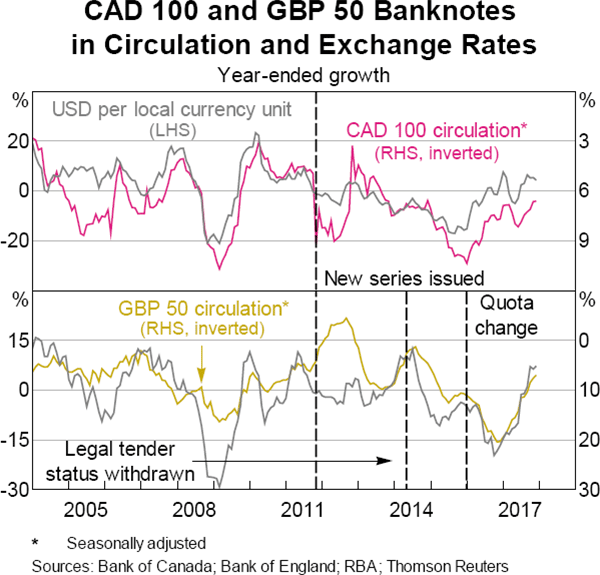
Quotas (GBP 50 banknotes)
Anecdotal evidence suggests that some customers have a preference for new rather than used high-denomination banknotes. This may be related to individual preferences, cultural norms or perceptions that, despite strong controls, commercially sorted banknotes might not always be counterfeit free.
The Bank of England previously imposed a limit on the volume of new GBP 50 banknotes issued into circulation (a quota) to encourage the recirculation of used banknotes; neither the RBA nor Bank of Canada impose such a limit. From January 2016, the Bank of England's quota policy was altered to increase the supply of new banknotes.[10] When the policy was changed, demand for GBP 50 banknotes increased. However, it is difficult to determine the precise impact of this policy change as it occurred at the same time as the exchange rate was depreciating, which also increased demand (Graph 6).
Black Economy Taskforce (AUD 100 banknotes)
Since peaking in late 2016, growth in demand for AUD 100 banknotes has declined considerably (Graph 4). This may partly reflect heightened uncertainty among consumers and businesses about the future status of AUD 100 banknotes following the Australian Government's announcement in December 2016 of the formation of the Black Economy Taskforce (BETF). This taskforce aims to investigate and identify where regulations and policies could be introduced to reduce activity occurring outside the tax and regulatory system (excluding illegal or criminal activities). The BETF convening announcement included, among many other options, a discussion around strong demand for AUD 100 banknotes and identified the use of cash as an area to be investigated, generating intense media interest. This announcement coincided with heightened public interest in the future of high-denomination banknotes following decisions in some jurisdictions to withdraw the legal tender status of some high-denomination banknotes (India and Venezuela) or to discontinue production and issuance (euro area).
Daily lodgements of AUD 100 banknotes into cash depots increased sharply after the BETF announcement (Graph 7). It may have been that the BETF announcement, and associated media speculation about the future of AUD 100 banknotes, contributed to uncertainty among the general public and prompted some to spend AUD 100 banknotes that were previously held as a store of value. Liaison with the cash industry has indicated that the increase in lodgements has been evident across a broad range of retail customers, has occurred in most states and has been concentrated in capital cities.
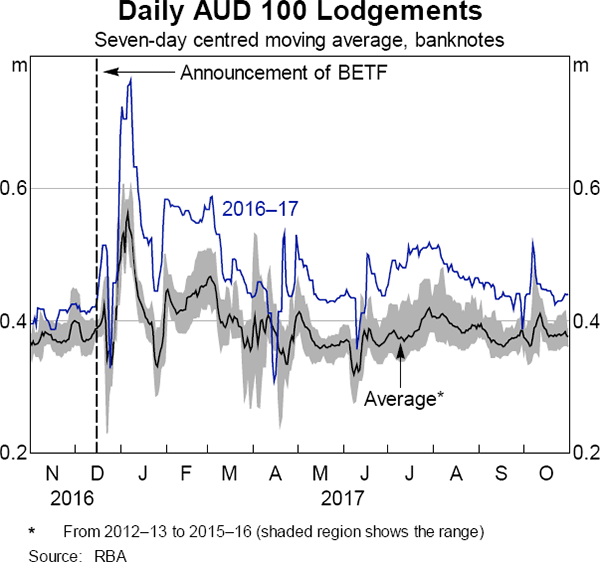
Conclusion
The recent strong growth in AUD 100, CAD 100 and GBP 50 banknotes in circulation has attracted considerable interest from policymakers, the cash industry and the general public. The shared experiences of the RBA, Bank of Canada and Bank of England suggest that a common driver of this elevated growth is likely to be overseas demand. For AUD 100 and CAD 100 banknotes, Asian demand appears to be of particular significance. Domestic transactional use and store-of-value motives seem to be less important, but still relevant. In addition, government and central bank policies in each jurisdiction in recent years have likely had transitory effects on high-denomination banknotes in circulation.
Appendix A
We can explore the relative importance of drivers of demand for high-denomination banknotes using regression analysis. We estimate a series of autoregressive distributed lag models using monthly data from November 2003 (February 2005 for GBP 50 banknotes) to November 2017. The general form is:
where ct is the seasonally adjusted month-end value of banknotes in circulation, USDt is the month-average US dollar exchange rate and Xt is a vector of other explanatory variables of interest including the CNY one-month 25 delta risk reversal, the value of retail sales, housing prices, the value of alterations and additions (Australia only) and short-term holiday arrivals (Australia and Canada only). All variables except the risk reversal are in logarithms. Dummy variables are also included for October–December 2008 to account for volatility around the time of the global financial crisis. A dummy variable for November 2011 is included in the CAD 100 and GBP 50 banknote regressions to control for the issue of new series.
Table A1 presents the results of the estimated models over the full sample and when the data are restricted to the post-crisis period. The lagged dependent variables have been excluded for brevity. Lag lengths were chosen based on parameter significance and the Akaike information and Schwarz criterions.
| ΔAUD100t | ΔCAD100t | ΔGBP50t | ||||
|---|---|---|---|---|---|---|
| Full sample | Post-crisis | Full sample | Post-crisis | Full sample | Post-crisis | |
| Nov 03–Nov 17 | Jan 10–Nov 17 | Nov 03–Nov 17 | Jan 10–Nov 17 | Feb 05–Nov 17 | Jan 10–Nov 17 | |
| Constant (α) | 0.0027 *** (0.0010) | 0.0029 *** (0.0010) | 0.0058 *** (0.0013) | 0.0062 *** (0.0012) | 0.0021 * (0.0012) | 0.0016 * (0.0009) |
| ΔUSDt (δ1) | −0.0514 *** (0.0109) | −0.0620 *** (0.0186) | −0.0763 *** (0.0129) | −0.0746 *** (0.0158) | −0.1416 *** (0.0175) | −0.1458 *** (0.0191) |
| ΔUSDt−1 (δ2) | −0.0358 *** (0.0128) | −0.0548 ** (0.0221) | −0.0640 *** (0.0174) | −0.0709 *** (0.0158) | −0.0426 (0.0274) | −0.0172 (0.0297) |
| ΔUSDt−2 (δ3) | −0.0197 (0.0143) | −0.0150 (0.0214) | −0.0272 * (0.0146) | −0.0360 ** (0.0171) | – | – |
| Risk Reversalt (γ1) | 0.0413 * (0.0242) | 0.0338 (0.0415) | 0.0182 (0.0304) | 0.0716 * (0.0372) | 0.0400 (0.0469) | 0.0035 (0.0529) |
| ΔRetailSalest (γ2) | 0.1056 * (0.0551) | 0.0030 (0.1012) | 0.0183 (0.0189) | 0.0480 ** (0.0213) | 0.0228 (0.0439) | −0.0193 (0.0534) |
| ΔHousing Pricest (γ3) | 0.0408 (0.0391) | 0.0058 (0.0401) | 0.1167 *** (0.0425) | 0.1495 *** (0.0528) | 0.1209 * (0.0695) | 0.1423 (0.0964) |
| ΔAlts Addst (γ4) | 0.0070 ** (0.0028) | 0.0031 (0.0042) | – | – | – | – |
| ΔHoliday Arrivalst (γ5) | 0.0062 (0.0048) | 0.0129 ** (0.0054) | −0.0013 (0.0083) | −0.0027 (0.0103) | – | – |
| Dummy variables | ||||||
| GFC (2008:10) | 0.0168 *** (0.0024) | – | 0.0087 *** (0.0015) | – | 0.0245 *** (0.0033) | – |
| GFC (2008:11) | −0.0042 ** (0.0021) | – | 0.0009 (0.0023) | – | 0.0003 (0.0031) | – |
| GFC (2008:12) | −0.0105 *** (0.0030) | – | 0.0007 (0.0016) | – | −0.0162 *** (0.0031) | – |
| New series (2011:11) | – | – | 0.0360 *** (0.0004) | 0.0363 *** (0.0005) | −0.0107 *** (0.0017) | −0.0082 *** (0.0014) |
| Summary statistics | ||||||
| Adjusted R2 | 0.4784 | 0.4072 | 0.6285 | 0.8347 | 0.4408 | 0.5055 |
| SD of dependent variable | 0.0051 | 0.0047 | 0.0049 | 0.0054 | 0.0078 | 0.0073 |
| SE of regression | 0.0037 | 0.0037 | 0.0030 | 0.0022 | 0.0058 | 0.0051 |
|
(a) *, **, *** denotes significance at the 10, 5 and 1 per cent levels respectively; all variables are in log differences expect the risk reversal variable which is in levels Sources: ABS; Australian Property Monitors; Bank of Canada; Bank of England; Bloomberg; HM Land Registry; Office for National Statistics; RBA; National Bank of Canada; Statistics Canada; Teranet; Thomson Reuters |
||||||
Footnotes
The authors completed this work in Note Issue Department. This paper was prepared as part of the Four Nations Distribution Working Group with contributions from Carolina Labrador, Bill Laur and Christian Roy from the Bank of Canada and Callum Miller and Tom Stumbke from the Bank of England. [*]
The Four Nations Distribution Working Group comprises representatives from the currency departments from Reserve Bank of Australia, Bank of Canada, Bank of England, Banco de Mexico and the US Federal Reserve. [1]
A notable exception is Sweden, where banknotes in circulation have declined by more than 40 per cent since 2007 and the currency-to-GDP ratio has declined from around 4 per cent in the early 2000s to around 1½ per cent in 2016. This reflects a range of factors including an overwhelming preference among many consumers for electronic payment instruments, technological innovation and government policies (Segendorf and Wretman 2015). We do not explore the idiosyncratic differences between cash use in Sweden and other advanced economies in this article. [2]
Liaison with the cash industry indicated that the sharp increase in lodgements in early 2017 occurred in most state capital cities and was from a broad range of customers. [3]
When introducing a new series of banknotes, central banks often encourage the accelerated removal of the old series by allowing fit banknotes to be returned and exchanged for new series banknotes. [4]
For Australian data there is some evidence of a breakdown in the correlation between retail sales and the total value of lodgements across all denominations since 2012 (the relationship between lodgements and retail sales is not discussed in detail in this article). This could be due to a number of factors including the rising popularity of electronic payment methods and improvements in cash storage technologies for large retailers (Flannigan and Staib 2017). [5]
Otani and Suzuki (2008) found that demographics can also affect store-of-value demand in the case of the Japanese yen, as the elderly are more likely to hold banknotes for savings and other non-transactional purposes. [6]
Bank of Canada data on damaged banknotes include commercial bank and household claims. [7]
This could have been further supported by the International Monetary Fund's recognition of the Australian and Canadian dollars as reserve currencies in 2013. [8]
Paper CAD 100 banknotes were declared unfit on the same day the new polymer series was issued, meaning they could be returned to the Bank of Canada for destruction (regardless of quality). To facilitate the accelerated withdrawal of the paper series, additional polymer banknotes were required by commercial banks prior to the actual replacement transaction occurring. [9]
The RBA does not meet specific requests for new AUD 100 banknotes and will reissue previously returned fit banknotes, where available, before new banknotes are used. The Bank of Canada applies a nominal fee for new CAD 100 banknotes where they are requested to cover the additional administration costs. [10]
References
Arango C and A Welte (2012), ‘The Bank of Canada's 2009 Method-of-Payments Survey: Methodology and Key Results’, Bank of Canada Discussion Paper 2012-6.
Cusbert T and T Rohling (2013), ‘Currency Demand during the Global Financial Crisis: Evidence from Australia’, RBA Research Discussion Paper No 2013-01.
Davies C, M-A Doyle, C Fisher and S Nightingale (2016), ‘The Future of Cash’, RBA Bulletin, December, pp 43–52.
Doyle M-A, C Fisher, E Tellez and A Yadav (2017), ‘How Australians Pay: Evidence from the 2016 Consumer Payments Survey’, RBA Research Discussion Paper No 2017-04.
Fish T and R Whymark (2015), ‘How has Cash Usage Evolved in Recent Decades? What Might Drive Demand in the Future?’, Bank of England Quarterly Bulletin, Q3, pp 216–227.
Flannigan G and A Staib (2017), ‘The Growing Demand for Cash’, RBA Bulletin, September, pp 63–74.
Henry C, K Huynh and Q Shen (2015), ‘2013 Methods-of-Payment Survey Results’, Bank of Canada Discussion Paper 2015-4.
Judson R and R Porter (2004), ‘Currency Demand by Federal Reserve Office: What Do We Know?’, Journal of Economics and Business, 56(4), pp 273–285.
Lowe P (2017), ‘An eAUD?’, Address to the 2017 Australian Payment Summit, Sydney, 13 December.
Miller C (2017), ‘Addressing the Limitations of Forecasting Banknote Demand’, in International Cash Conference, Proceedings of a Conference, The Deutsche Bundesbank, Island of Mainau.
Otani A and T Suzuki (2008), ‘Background to the High Level of Banknotes in Circulation and Demand Deposits’, Bank of Japan Review 2008-J-9.
RBA (2017), ‘Box B: Chinese Direct Investment’, Statement on Monetary Policy, November, pp 29–30.
Segendorf B and A-L Wretman (2015), ‘The Swedish Payment Market in Transformation’, Sveriges Riksbank Economic Review, 2015(3), pp 48–68.
